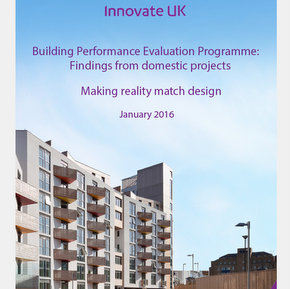
UK buildings carbon emissions scandal
 Howard Chapman, Buildingtalk Editor on the latest carbon reduction reports that show alarming discrepancies between projected savings and actual results.
Howard Chapman, Buildingtalk Editor on the latest carbon reduction reports that show alarming discrepancies between projected savings and actual results.
Data from Innovate UK’s Building Performance Evaluation Programme was analysed for new Goverment reports that demonstrate UK buildings emit far more carbon than they were designed to.
Many modern domestic and commercial buildings are falling short of performance expectations and this undermines UK plans to reduce greenhouse gases by 80% by 2050.
- buildings were routinely using up to 3.5 times more energy than their design had allowed for
- only one of the 48 buildings studied produced the amount of carbon specified by its design.
- total emissions were sometimes 10 times the rate calculated for Part L compliance
The Building Performance Evaluation Programme on ‘actual’ carbon reduction show alarming discrepancies between projected savings and actual results.
It advises constructors on strategies to ensure modern, low-carbon domestic buildings meet expectations after findings that many do not.
Links to download reports:
Domestic Buildings – recommendations
- Handover is a critical opportunity to explain to residents how to operate their homes in different seasons – and outline any maintenance they might need.
- Prepare clear instructions, and leave a simple summary for householders to refer to afterwards.
- Do not assume that actual carbon emissions have any link to estimates of emissions needed for planning consents (also used in Energy Performance Certificates).
- Do not rely on Building Regulations alone to limit energy use and carbon emissions from new buildings.
- Biomass heating and heat pumps are no guarantee of low-carbon emissions.
Non-Domestic Buildings – recommendations
- Put simplicity first – especially when it comes to controls
- Do not substitute systems and controls for lower-cost alternatives if they are harder to use – and potentially unmanageable.
- For Passive House projects, find contractors experienced in meeting Passive House standards.
- Ensure all operatives understand the importance of airtightness, and how to avoid puncturing an air barrier.
- Allow extra time in the programme for innovative systems. Installation often takes longer than expected, and full commissioning before handover is essential.
- Ensure individual installers have previously and successfully installed the systems you are using in similar contexts.
Making reality match design
These report recommendations are a useful starting point if we are to narrow the gap between theoretical savings and real savings in carbon emmissions.
Latest news

27th November 2024
SWA guides on the installation of steel windows and doors
The Steel Window Association has developed a series of fact sheets; all are viewable and downloadable here. The following is a synopsis of the installation fact sheet which has been compiled by the industry’s experts.
Posted in Articles, Building Industry News, Building Products & Structures, Building Regulations & Accreditations, Building Systems, Doors, Glass, Glazing, Innovations & New Products, Publications, Research & Materials Testing, Restoration & Refurbishment, Retrofit & Renovation, Steel and Structural Frames, Windows
27th November 2024
Abloy electronic access control: Ensuring safe escape door compliance in schools
Paul Nicholas, at Abloy UK, discusses the importance of escape door compliance in schools, and specifying the correct electronic access control solution to ensure life safety.
Posted in Access Control & Door Entry Systems, Architectural Ironmongery, Articles, Building Industry News, Building Products & Structures, Building Regulations & Accreditations, Building Services, Doors, Facility Management & Building Services, Health & Safety, Innovations & New Products, Posts, Retrofit & Renovation, Security and Fire Protection
27th November 2024
Hambleside Danelaw Top 5% in EcoVadis Assessment
Hambleside Danelaw has completed the EcoVadis assessment process, being awarded a Gold medal, categorising the company in the Top 5% of all companies in the EcoVadis database over the last 12 months.
Posted in Articles, Building Associations & Institutes, Building Industry News, Building Products & Structures, Building Regulations & Accreditations, Building Services, Drainage, Guttering, Soffits & Fascias, Lighting, Restoration & Refurbishment, Retrofit & Renovation, Roofs, Site Preparation, Sustainability & Energy Efficiency, Walls, Waste Management & Recycling
27th November 2024
Russell Dean of Mitsubishi Electric on DESNZ announcement
Russell Dean, Deputy Divisional Manager at Mitsubishi Electric, discusses the package of measures announced by DESNZ last week…
Posted in Articles, Building Associations & Institutes, Building Industry News, Building Products & Structures, Building Regulations & Accreditations, Building Services, Facility Management & Building Services, Heating Systems, Controls and Management, Heating, Ventilation and Air Conditioning - HVAC, news, Pipes & Fittings, Plumbing, Sustainability & Energy Efficiency
 Sign up:
Sign up: 